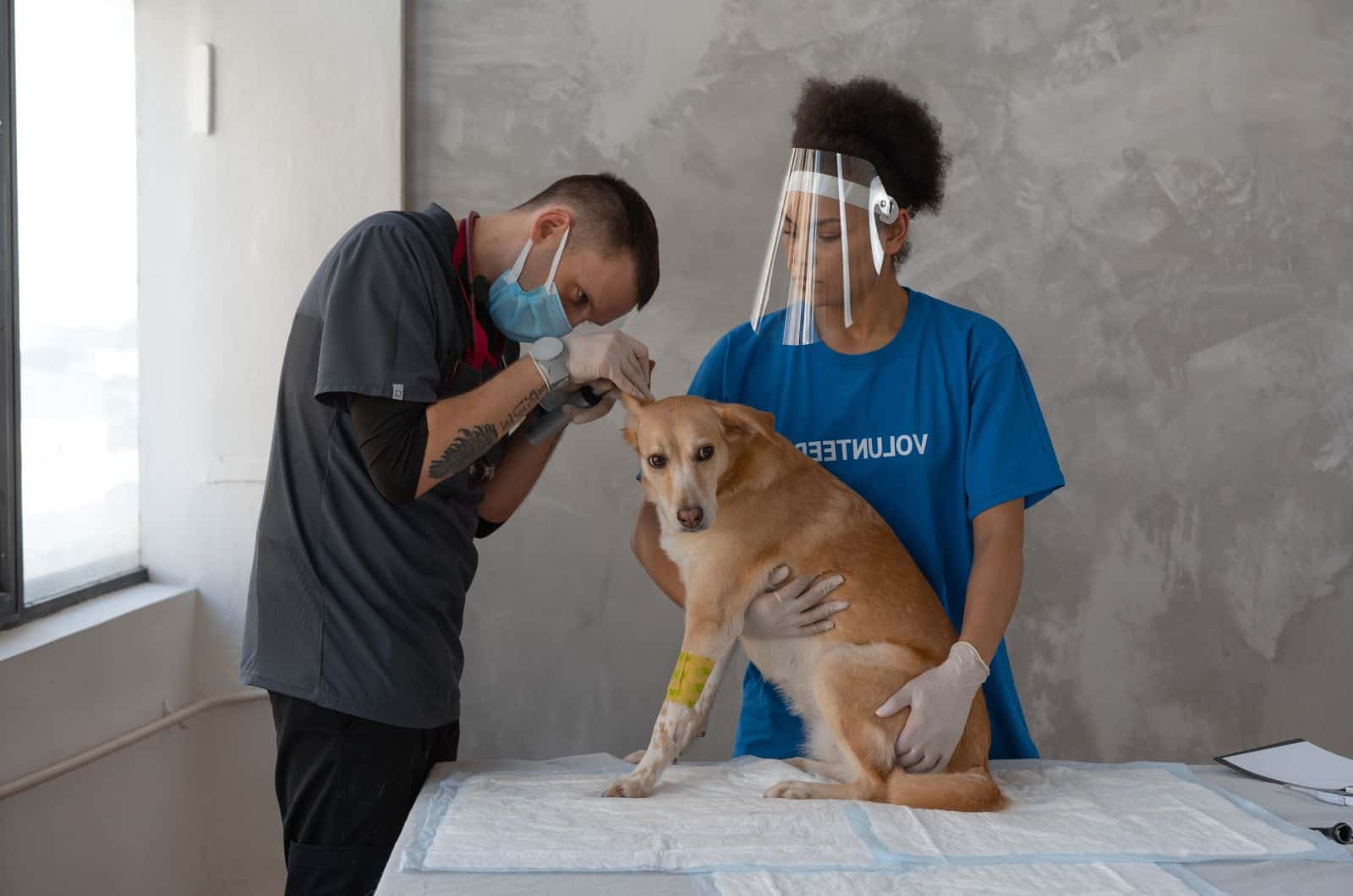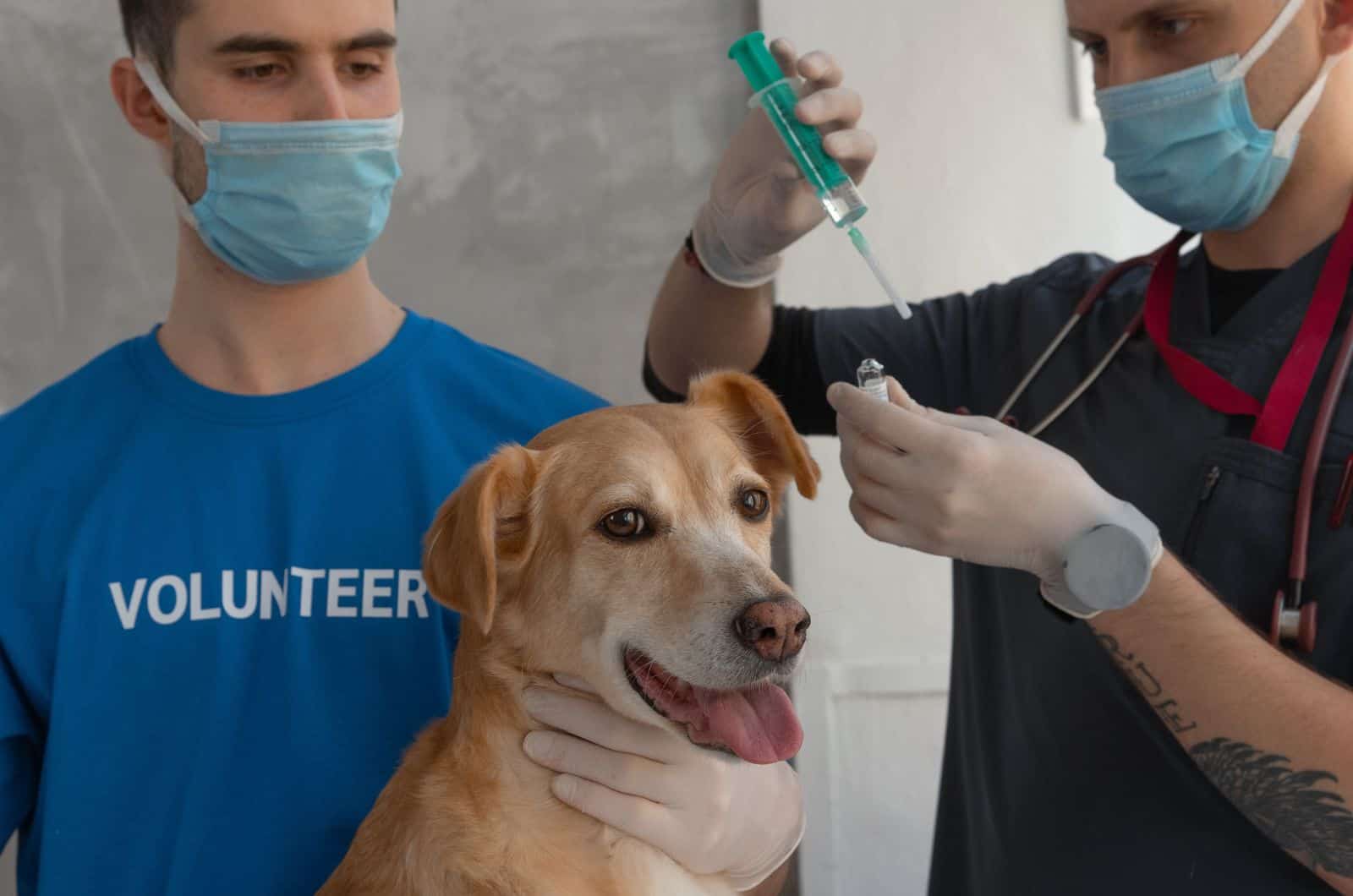What on Earth is going on with dog owners nowadays? I can accept dog “customization” by getting some raincoats and knitwear on your canine companion, but a piercing? Just talking about this boggles the mind.
Fashion trends are great and all, but there needs to be a line between fashion and what is considered animal cruelty. Whether you have a designer breed or not, dog breeds should not play any role in validating an ear piercing.
Putting aside my personal opinion, there are medical reasons why dog ear piercings should be gone from people’s minds. This article will not be a rant but a structured, fact-fueled piece of text.
The Law Says Dog Ear Piercings Are Animal Abuse

No convention in the Solar system calls for ear piercing as anything close to necessary or desirable on dogs. Dog associations and clubs such as the AKC and many breeders uphold breed standards that require ear cropping and tail docking.
While I do not agree breed standards should impose rules demanding body alteration, I can understand, to a certain point, the need to preserve a breed’s traditional look. When I was a kid, I did not know Dobermans had their tails docked, or that ear cropping was a thing with Schnauzers.
In the United Kingdom and Australia, breed standards that impose body alteration were changed to fit in natural ears and tails, and ear cropping and tail docking were prohibited. In the US, there is still no legislation prohibiting such procedures.
Arguing that those two well-established body alterations are animal cruelty certainly warrants completely dismissing dog ear piercing as something the owners are free to do.
Piercing a dog’s ear is a form of animal cruelty, so you can be charged with animal abuse and end up paying a fine or felony prison time for piercing your dog’s ear.
When You Pierce A Dog’s Ear, You Invite Health Issues Into Its Life

I believe this goes without saying — any unnecessary anatomical modification on a dog’s body has risks. Drawing once again a parallel with ear cropping and tail docking, dog piercing is as unnecessary as body alteration goes.
What is considered animal abuse is not defined by a dog owner’s sense of fashion but by ethical and reasonable conduct. Animal medical associations and organizations dealing with animal health are against body alteration that is medically unnecessary.
Those who believe the law does not have a right to impose such “stylistic” limits to their fashion sense expressed through a dog’s pierced ear should at least be aware of the many health concerns dog ear piercings can cause.
1. Piercing Your Dog’s Ears Causes Unnecessary Pain
Writing about dog ear piercings causes me unnecessary pain. I can only imagine how confusing and painful it is for a dog to get an ear piercing. The human ear has areas with fewer nerve endings that are pain-free.
Because of that, ear piercings are usually painless. However, if you pierced some part of your body that is full of nerves, you know it hurts like hell. A dog’s ear is full of nerve endings that stem from branches of the facial nerve.
Not only does the ear lobe hurt when it is pierced, but the signal is sent through every single nerve extension connected to the facial nerve.
For comparison, imagine a searing tooth pain that branches out into your facial nerve, and you will be on track to understanding how piercing the ear can stimulate the pain center in the brain.
2. Dog Ear Piercings Can Cause Nerve Damage
The needle that pierces the dog’s ear is essentially an injury to the ear lobe tissues and nerves. In addition to a much richer innervation, dog ears have a lot more mobility than human ears, thanks to the muscles all around them.
Like any injury, no matter how small, the piercing will cause trauma to the skin, cartilage, capillaries, and peripheral nerves. Sensitive ears will feel more pain for a longer period of time.
Since dogs cannot understand why this is happening or how to deal with it, they will scratch the ear and potentially create more damage than the body piercing itself did.
Nerve damage sustained through injury causes neuropathic pain, and it always becomes a chronic condition. This is detrimental to a dog’s quality of life, as the ears are an indispensable asset in everyday life.
Managing the pain requires constant use of pain meds, which is added as a reason for a lower quality of life. An anti-seizure medication called gabapentin is commonly used for neuropathic pain management, but it has some contraindications like ataxia, weight gain, and diarrhea.
Nerve Damage Can Affect Your Dog’s Ability To Express Its Mood
The affected nerve damage can lead to complete loss of sensation in the ear. Death of the peripheral nerve can continue until it reaches a major branch closer to the root of the facial nerve.
When this happens, your dog might lose control of the muscles surrounding the nerve. Most commonly, the ear will droop, causing the dog to lose full range of motion and the ability to partially or fully erect the ear.
Communicating mood is key in the social life of a dog. Still, the anatomical function of positioning the ear for better sound directionality is even more important for your dog, and piercing an ear can lead to these problems.
3. Ear Infections Are Possible If You Pierce Your Dog’s Ear

Piercing a human ear carries the risk of infection too. It is common to have swelling and discharge after piercing ears. Removing the piercing for a while and then putting it on again can create the same problem too.
While our ears are quite far from germs found on the ground, food, etc., dogs do not have the luxury of being as tall as we are. Exploring around the yard, squeezing through tight spots, or simply rolling around in the dirt makes it easy for pathogens to enter the wound.
Dog ear hygiene in some breeds is difficult as it is, so increasing the likelihood of ear infections by causing unnecessary injury is the last thing pet dogs need.
Otitis Externa Is Common In Dogs, But Piercings Can Increase The Risk
A dog’s well-being should be the primary concern of every owner, and reducing the risk of health problems is the best possible prevention method. Adding another risk factor is negligence, and laws should have harsher fines for irresponsible owners who do this.
Ear infections can be fatal for a dog if left untreated. Cases of otitis externa that are caught early are usually dealt with easily. A round of oral and topical antibiotics should sort out the infection from spreading deeper into the ear or blood flow.
Clot formation during the healing period of the wound can obstruct blood flow into the ear, causing the tissue around it to stop receiving nutrients. Cartilage, skin, and nerve deterioration can ensue, leading to a systemic infection.
Symptoms of an ear infection can include swelling, redness, discharge, or a foul odor. A dog that constantly scratches its ears or shakes its head is reason enough to visit the vet. Ear infections that spread to the middle and inner ear can easily cause hearing loss or brain damage.
In many cases, fungal and bacterial infections have similar symptoms, so lab analysis is required to diagnose the cause and recommend adequate treatment.
Treating ear infections can be exponentially harder if your dog has underlying health conditions that you were unaware of, such as allergies or thyroid issues. In case the ear canal becomes partially or entirely closed, surgery is a likely option.
4. Pyoderma (Skin Infection)
Ear piercing affects all types of tissue in the ear, and the skin is one of them. Because the pinna (outer shell of the ear) is very thin and delicate, the metal bit will damage all the tissue layers.
The balance of normal bacteria and flora that live on the surface of the skin becomes disturbed when moisture from the dog’s ear hair enters the wound. Germs thrive in humid conditions, and a small entry point is enough to enter the lower layers of the skin.
A dog’s hair keeps moisture and dirt, so the conditions for the development and multiplication of germs are ideal. Paws get dirty easily, and the dog scratching the wound can enlarge the wound.
Pushing their heads through narrow fence holes or making their way through bushes can create tears in the tissue due to the piercing stretching the skin until it ruptures.
The most frequent manifestation of pyoderma is pimple-like bumps filled with pus. A red contour around each of the pustules means that the capillaries are burst, and if the bumps are popped, more pathogens are able to invade the tissue and blood.
Sores or hairless spots are a couple of symptoms of an active infection that are easy to notice. Depending on the coat type and color, they might be harder or easier to see.
Determining whether it is fungal or bacterial is crucial for proper treatment, as antibiotics can worsen a fungal infection, and anti-fungal meds can promote bacterial growth in the wound.
For more advanced infections, oral antibiotics or anti-fungal meds are an effective treatment in more severe cases. Ointments on their own are great for a mild infection but can be used to reduce the number of oral antibiotics if the condition is improving.
5. Hearing Loss Is Not A Farfetched Consequence

Whether caused by an ear infection or nerve damage, hearing loss can change your dog’s and your life in a major way. A dog relies on its ears to assess danger in addition to facilitating efficient intra-species and inter-species communication.
A slow or lack of response to auditive stimuli can have a big impact on your relationship and quality of life, which in my opinion, is not even remotely worth it. Keep in mind that partial deafness is much harder to diagnose because the dog can still hear, albeit in a lesser capacity.
Hearing tests must be performed to confirm the extent of the damage, but if you notice your dog tilting its head while receiving sonic information, it could be a partial loss of hearing. Incessant scratching and head shaking are frequently directly connected to hearing issues.
6. A Dog’s Lifestyle And Social Life Can Suffer Too
If you grew up with animals around, you know that a dog’s life is built around curiosity and regular physical activity. I hope you can see how a permanently attached piece of metal in its ear can create issues in living life the way it is meant to be lived.
Playing with other dogs can suddenly become very difficult. Friendly wrestling sessions between dogs are like training for a fight — they simulate scenarios of a real fight in a controlled and socially acceptable manner.
Handicapping your dog by introducing a weak spot other dogs can exploit is irresponsible. Animals could not care less about their “drip”, and the only party getting something out of it is the human owner.
While a “dog lover” who pierces their dog’s ear might enjoy unprecedented attention regarding an odd choice of self-expression at the expense of a dog’s quality of life, the dog can suffer not only physically but in terms of socialization too.
Dogs instinctually and through body language know if another dog or animal is weakened, insecure, or has a defect. If a stray dog approaches your dog, the scent of the metal in the ear can put it off and snap at your dog.
If your dog gets bitten on the ear, the piercing will likely cause more damage than the bite itself. Whether you have a Pitbull or Chihuahua, the effect will be the same. Other dogs who are friendly to your dog might decide to avoid it due to this strange object.
A dog feeling constant pain or being prevented from activity due to itchy ears or hearing loss will feel insecure and may become depressed. This is quite apparent to other dogs and might create a hostile environment that can impact proper socialization.
Unsettled dogs can become unhealthily attached to their owner due to the mental stress insecurity produces. It is possible they will find comfort in always being by your side and refusing to socialize with others dogs or where strangers are present.
If You Still Decide To Disregard The Downsides
Yes, piercing your dog’s ear is physically possible. The fact that it only has downsides might not phase you, and you might go through with it. In that case, let me tell you — a licensed veterinarian is the only person you should ask to do this.
However, any veterinarian who has ethics in doing his job will not agree to do an ear piercing, so you will have difficulties finding one. Getting any other person (or yourself) to pierce your dog’s ear is a terrible choice that you will regret — just like the idea of a dog ear piercing itself.
If you think a dog ear piercing is the same as the tag animal control puts on stray dogs, then you are completely wrong. An ear tag has the purpose of marking a stray dog — it means it was spayed or neutered.
New methods are available, which means tagging is not done in all parts of the world. Even the tags raised a lot of debate on the topic of humane ways to mark neutered or spayed dogs, so a cosmetic accessory, such as an ear piercing, is worse for it.
Final Touches

If the thought of dog ear piercings crossed your mind when you stumbled upon this article, you might have taken the text as a rant or scolding. The goal is far from that. A dog’s health takes precedence over accessorizing, and the point needs to be stressed.
I was stressed writing about it, and you were probably stressed reading it, so let us compromise by piercing my ears. Just leave the dog out of this, and have at it.
Every dog breed has something for all of the people who like their dog to be a visual statement. There is nothing wrong with that.
You can always get some unique collars, weighted harnesses, or clothes to make your canine friend stand out among the doggie crowd.
On a serious note, piercings are animal abuse, just like feeding dogs a vegetarian or vegan diet. In a world where the growing trend of seeing animals as items or fashion statements is gaining traction, we need to educate people about what having a dog means.
For me, having a dog is an essential part of life. As a kid, my family always had dogs, cats, birds, you name it, so my day would not be complete without a little obedience training, tummy scratching, or ear massage before going to sleep.
A dog’s character is as unique as your personality, so strive to better yourself, and your dog will follow your lead. For those of you who have never entertained the idea of a dog ear piercing but witnessed cases of it, contacting the ASPCA is the right thing to do.













